If you’ve been following photography lately you would have noticed there has been a bit of a buzz over the new Fujifilm X100S due to the cult following the X100 developed (pun intended). The Fuji X100S is being called the new Leica and is receiving praise from all who review it. There is another camera that has a similar following that deserves a comparison. This is not going to be soley a tech spec comparison, it’s going to be a short real world comparison written by someone who shot exclusively with the OMD EM5 for just over four months and is now shooting exclusively with the X100S (read about the Fuji X100S Challenge).
Specs
Click the image to enlarge
Handling and Aesthetics
I loved my EM5… the Fujifilm looks and feels richer. Both cameras have a lot of plastic but the X100S feels like a more solid camera when you pick it up. I used to think the OMD was a rugged camera but after holding the X100S I feel as though the OMD was a bit on the chincy side. I know some of you are thinking, “What! The OMD is weather resistant and so on…”, and I get that. All I’m telling you is the X100S feels more solid than the OMD, a lot more. The OMD feels more square in your hands as well, while the X100S has rounded corners and edges giving it a better feel.
I used to think the OMD was a rugged camera but after holding the X100S I feel as though the OMD was a bit on the chincy side.
The OMD edges out the X100S in the grip department, the X100S is not a camera you want to carry around without some sort of strap. The OMD has a small nub on the back for your right thumb to grip onto while the X100S is downright slick. I wish the X100S had used another material to wrap their camera with, something with a little more grab.
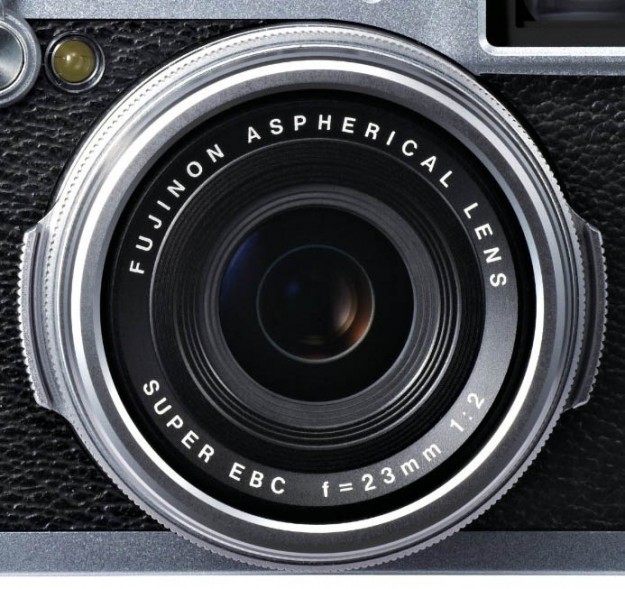
The X100S has the beautiful Fuji 23mm fixed lens permanently affixed to its face so the camera is always aesthetically pleasing and well proportioned. The OMD has the advantage of being able to use multiple lenses, unfortunately they all make the camera look disproportionate in size to the lenses attached to it and work against it in the handling department. The EM5 is either too small or too large for most of its lenses. The only lens that truly fit that camera well (and is the best lens available for it) is made by Panasonic, the Pana 12-35mm f/2.8 (and it will cost you over a grand). If you want a fixed lens on the OMD to compare apples to apples (size and handling) you’ll have to settle for a crappy pancake lens by Olympus or Panasonic. If you want to compare apples to pears you could affix the 12mm f/2.0 lens by Olympus ($800) but then your back to a disproportionate mess, the OMD will try to topple over onto it’s face when you set it down with the 12mm lens.
I’ve got small hands, small masculine hands… When I hold the OMD I immediately feel as if it’s smaller than it should be, it’s got one foot in the “I want to be a small mirror-less camera” camp and another foot in the “I want to have interchangeable lenses like the big boys” camp. What this means is that the body of the camera feels too small compared to the lenses you’ll attach to it, it looks rather silly and feels awkward.
Actual Use
I shoot primarily in manual mode, once in a while I will shoot in aperture priority mode if I’m in a hurry. I like my camera to “get out of my way” as the pros say. I want a camera that will let me adjust the main settings from buttons and dials strategically placed so that I don’t have to pull my eye away from the viewfinder when I do it. Both cameras achieve this, it really comes down to preference. When I use the OMD it feels as though I’m using a camera that looks retro but is state of the art. When I use the X100S I feel as though I’m using a state of the art retro camera with retro controls and that feels good. The X100S will give you the feeling of going back to the basics without actually going all the way back to the basics.
With all that being said, the X100S is not for the beginner photographer. Sorry but there is no automagic mode to be found on the camera. The X100S is targeted at the pro or enthusiast photographer that really knows their way around the manual settings of a camera. If you are proficient with manual settings then you will find the X100S a pleasure to drive, more so than the OMD.
If you aren’t proficient with manual settings and are determined to buy the Fuji camera then I suggest you read my article Simple Guide to Using Your Camera in Manual Mode. One of the cool features the Fuji camera has is the aperture ring around the lens, it really gives you a nostalgic feeling when you’re dialing in the aperture and adjusting focus all around the lens of your camera.
It’s not all sunshine and butterflies with the X100S though, the auto-focus can get tripped up once in a while where the OMD is the fastest auto focus I have ever used. Manually focusing eliminates that gripe though and whether you are a pro at manual focusing or are a newbie you’ll be able to use the X100S in manual focus mode without a problem. Focus peaking is one of the best features the X100S has and one that the OMD owners have been asking for since the cameras release. If you are unfamiliar with focus peaking then read my article What is Focus Peaking.
The OMD really shines when it comes to filters and shooting modes, who needs Instagram when you’ve got 30 plus filters right on your camera. The X100S has a few different filters as well but where it really shines is the build in ND filter. You are able to slow the shutter speed down on the X100S in broad daylight to get some long exposure shots. Sure, it is not the same as using a 10 stop ND filter but it does have it’s advantages when shooting sun sets, rises, and everything between.
Pocketability
The OMD is pocketable if you wear cargo shorts with giant pockets to accommodate the lenses. If you decide you want to use a pancake lens so you can put it in your pocket then you will take a giant leap backwards in image quality. The X100S on the other hand is built perfectly to slip into your coat pocket or cargo shorts/pants pocket without sacrificing image quality.
JPEG vs. RAW
I’ll be brief here because I’m going to do a comparison article down the road. The Readers Digest version is that with the X100S JPEG’s are almost better than, if not the same as, RAW files up to about 6400 ISO. At 6400 ISO the RAW file retains more data to pull a more detailed photograph out of the data. Fujifilm has built a camera that generates an amazing JPEG. The OMD on the other hand creates a great JPEG but nowhere near the quality of the RAW files. Look for my comparison article over the next few weeks as I have more time to put the X100S through its paces.
Value
The OMD costs around $1000 for the body while the Fuji costs about $1300 for the body and lens. The OMD’s ability to accept interchangable lenses is its advantage and disadvantage here. There are a lot of choices for the OMD but only a few of them will give you comparable image quality to the X100s lens. The only lenses that get close cost anywhere from an additional $800 to $1400. I’ve shot with Micro Four Thirds lenses that cost less and you will be getting the same quality photographs you could have gotten with a camera for half the price. It’s like any camera, they are only as good as the glass you put in front of them. Therefore, I believe the X100S to be a better value. Think of it this way… If you are going to pay upwards of 2,000 for a camera and quality lens why wouldn’t you just buy a Nikon or Canon body and get a few primes that are leaps and bounds ahead of the M4/3 lens quality for a fraction of the price? Or you could save up an additional $500 and get a full frame D600 with a kit lens that would crush the image quality of just about any other camera (literally, the only camera with better image quality according to DxO Optics is its bigger brother, the Nikon D600.
The X100S is a great value out of the box but if you plan on using filters with it you’ll need to spring for the filter adapter which costs $50 or you can get the adapter and hood combo for $120. These should have came with the camera though. Like most cameras, you can find cheaper third party accessories but do a Google search to see if you can find reviews to make sure you’re not getting junk.
Conclusion
In a perfect world you would own both, right? Not exactly. The OMD has the reach with it’s interchangeable lenses while the X100S is a camera you could, and probably would, take with you everywhere you go. Image quality between the two will be explored further in another post but I imagine you’d have a hard time finding a M4/3 lens that surpasses the quality of the X100S at the same focal length (I tried, the 12mm was close but not the same focal length and the 12-35mm pana lens was the closest but fell slightly short).
If you are a pro or enthusiast then the X100S is a must have, you’ll find yourself opting for it over your D600 or D800 for your walking around camera. If you own a Nikon or Canon DSLR then the OMD may be more of the same albeit smaller. I don’t believe it would be worth the cost outlay to run both the OMD and a Canon or Nikon kit.
The OMD does everything very well and if you are looking for just one camera to own it would probably make a wise choice because of the ability to use multiple lenses. However, if you are going to pay multiple thousands for a camera I would recommend the D600 full frame with the kit lens over the OMD any day of the week.
Could the X100S be your only camera? Well, I’m about to find out. Bookmark PhotolisticLife or follow us by entering your email in the subscription box at the bottom of the page to continue to follow X100S updates on image quality, accessories, and experience. Over the next three months the X100S will be my only camera and I’ll be putting it to the test on everything from product photography to long exposure landscape photography. Thanks for reading.
Breakdown (OMD EM5)
The battery life will get you about 360 shots. This camera is fairly small but awkward with lenses attached. Whether you’re an enthusiast or novice you will be able to eek out some really great photographs in little to no time. The image quality is fairly good and gets better the more you invest in your lenses. The camera is around a grand and if you want a quality lens you’ll dish, at minimum, another $1000. The OMD is a great choice if you’ve got a spare $2500 to get the camera and a lens that will realize it’s full potential.
Update:
The auto focus refuses to lock onto any subjects when using in low light at times. (Reset the camera and auto focus is spot on, even in the lowest light) I don’t mean pitch black, I’m talking in an area that was lit with street lamps and most cameras would be able to lock focus fairly easily. The photograph below was taken using manual focus due to the fact that the x100s refused to lock focus in auto mode (I tried 10 or so times). On the plus side, this gave me a chance to use focus peaking (learn what focus peaking is here) which was amazing and negated the entire issue. I’m sure Fuji will come out with a firmware fix to address this issue but in the mean time you’ll need to familiarize yourself with manual focus and focus peaking.
In comparison, the OMD is the king of auto focus. Is the auto focus glitch with the Fuji make it impossible to use as your primary shooter? Absolutely not. The x1oos is still my preference over the OMD due to the incredible manual focus the Fuji camera has. If you have never used manual focus and you are looking for a camera that will make the learning curve less painful than the x100s with focus peaking is your savior. If you refuse to use manual focus then you may want to sit on the side lines until Fuji updates their firmware and the kinks are worked out with the x100s.
Breakdown (X100S)
The battery life will get you about 300 shots, slightly less than the OMD. You can literally drop this in your pocket and expect to get professional quality images. If you are a novice there will be a learning curve but nothing you can’t figure out in about an hour, enthusiasts will feel right at home. Image quality is incredible out of the box, gives the Nikon D600 and D800 a run for their money. The camera is slightly over a grand and another $120 for the filter adapter but that is it, great value. This could very well be the answer for many a photographer and you’ll be surprised how many people use it as their primary. The amount of freedom you have by not having to attach (and spend money on) several different lenses is immeasurable. This is one of the best cameras I’ve used.
Here are some more sample shots taken with the x100s:
Update (4/26/13)
After using the camera as my prime shooter for the last few weeks I have enjoyed the simplicity and freedom of the old school rangefinder setup. No lenses to lug around or bulky camera to hang around my neck. I’ve taken the x100s where I would have never taken any of my other cameras including the relatively small OMD. The photo quality the x100s is able to produce is incredible and leaves me wondering if I’ll ever switch back to a DSLR. Is it for everyone? No, if you are a wildlife photographer or sports photographer then this is not going to replace your DSLR, it would complement it. Below are some photographs I took after resetting the x100s and getting rid of the auto focus issues.

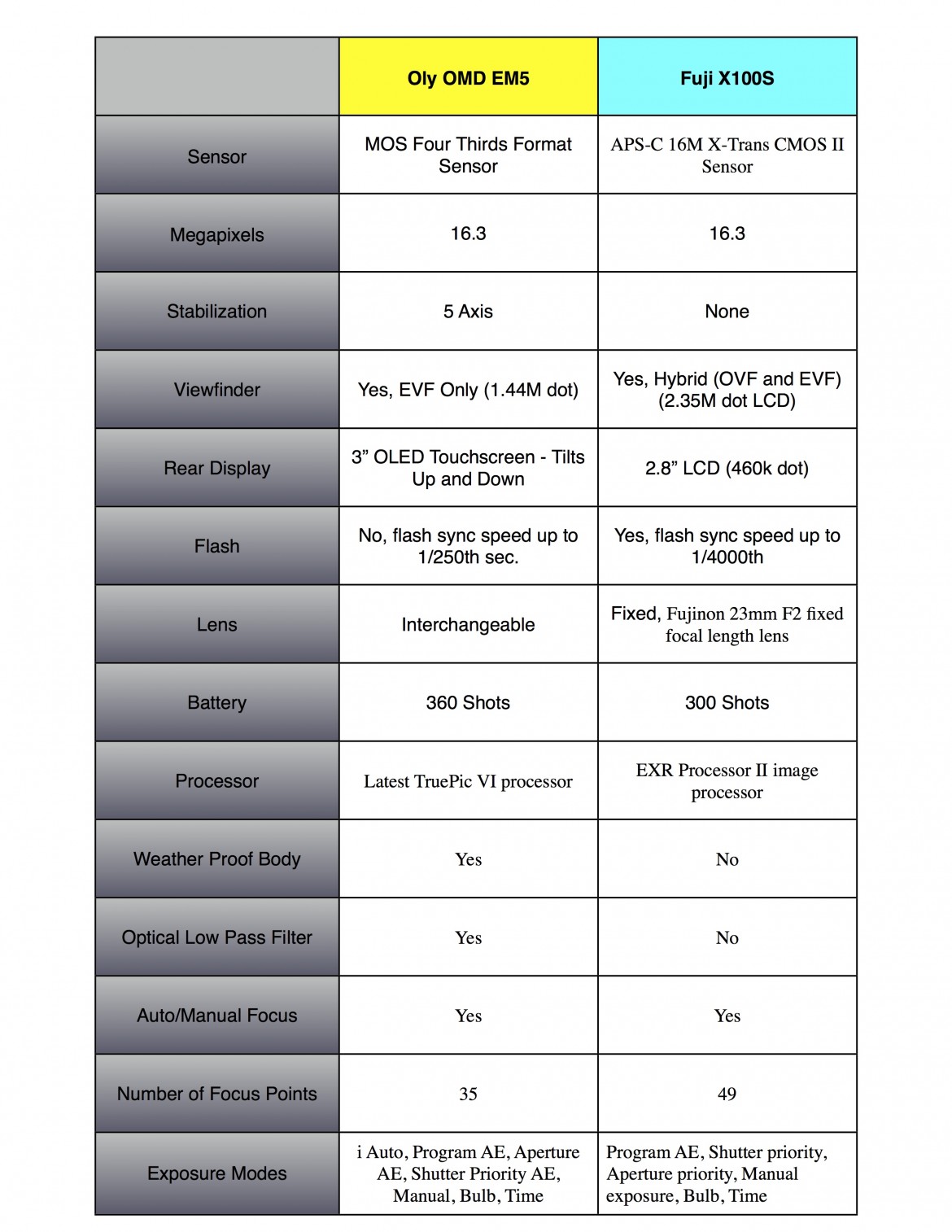
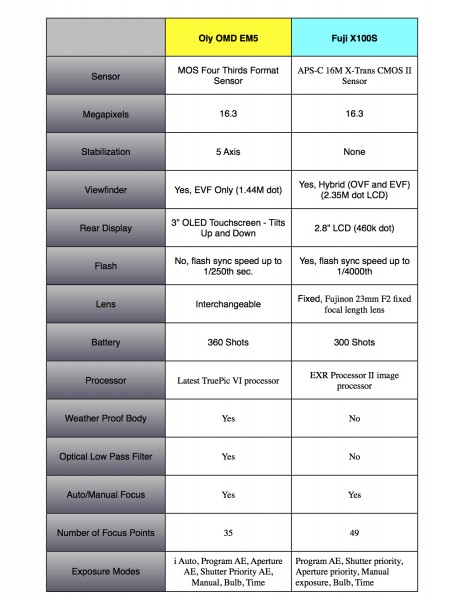


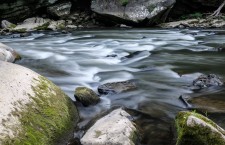


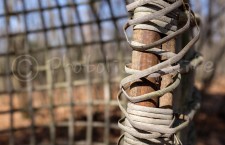
















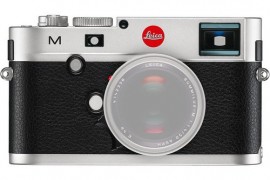

This is the best x100s review/comparison I have ever read. I have a x10, and after I’ve read this article, I’m sure the x100s will be my upgrade.
Thanks, you’ll love the camera. Enjoy!
Thanks for the review. Quick q: How do you reset the camera so the autofocus works better? Is this on firmware 1.02
I don’t have my camera with me right now but I believe it was under the wrench (settings) and I think the reset option was below the silent mode option. I’d try updating to v1.02 first as that improved it even more (I was on v1.01 at the time). Hope that helps.
Very good review, thanks. So I’m testing and having the X100s, the xe2, Sony a6000, Olympus me10 mark2. X100s is slow autofocus. Bothers me a bit. But images are wow. Can it be it’s better than xe2. Or is it all about lens? Ooc IQ and focus speed are priority above having many features.
May opt for two of these cams. What would you choose if you were me?
Thank! Great question and it’s hard to say since I have not used all of those. I loved my X100s and would recommend that to anyone looking for a very capable camera. The X100T is faster with autofocus if you’ve got the extra cash. Or maybe just wait till after Photokina (spelling?) this fall to see what new cameras get announced. Thanks for reading, take care.